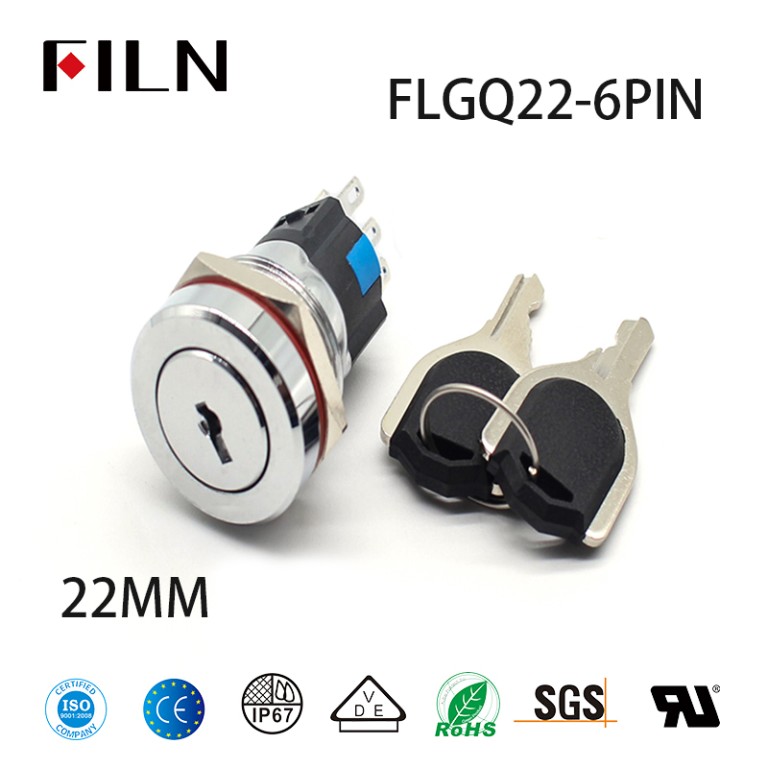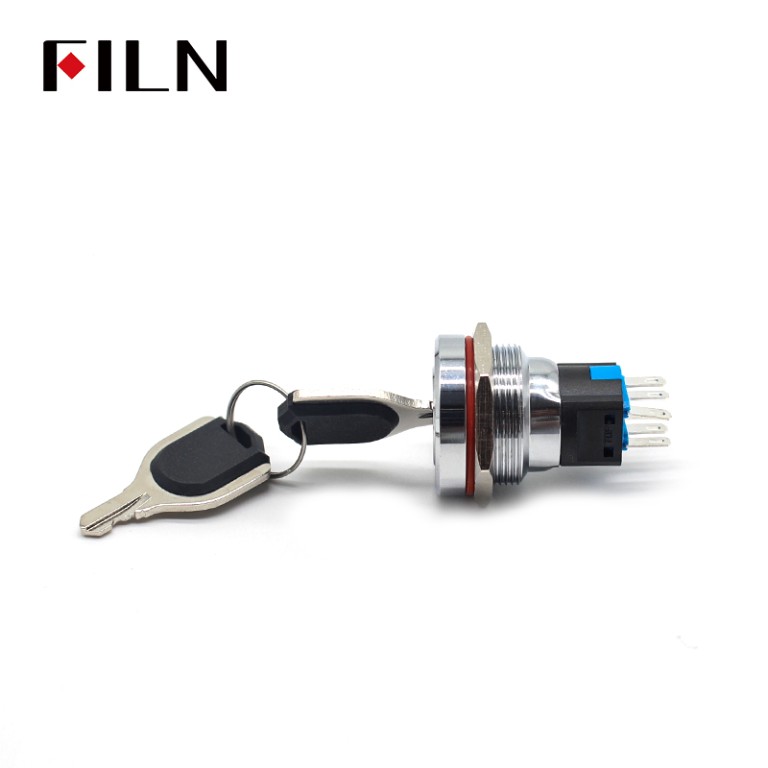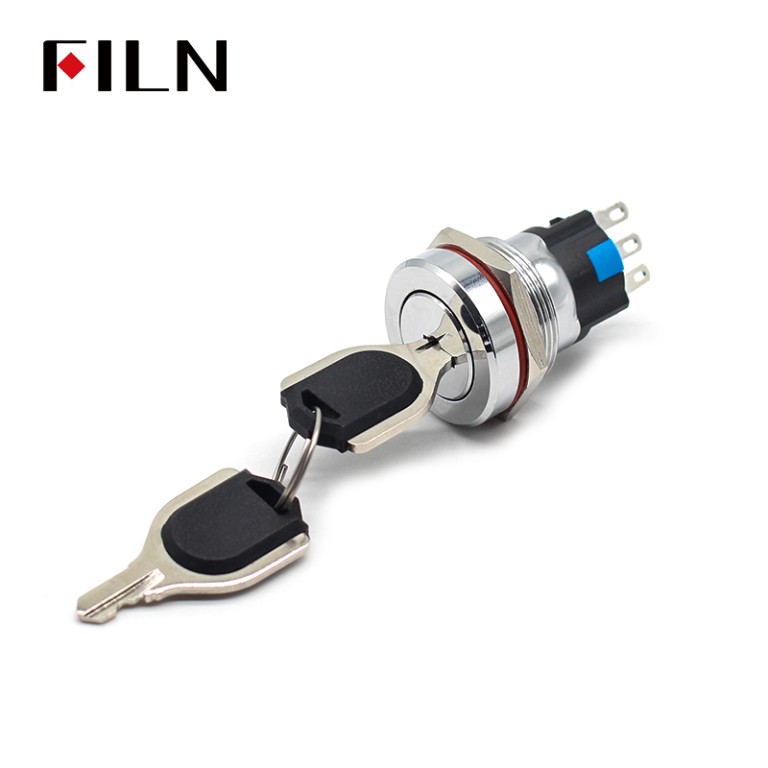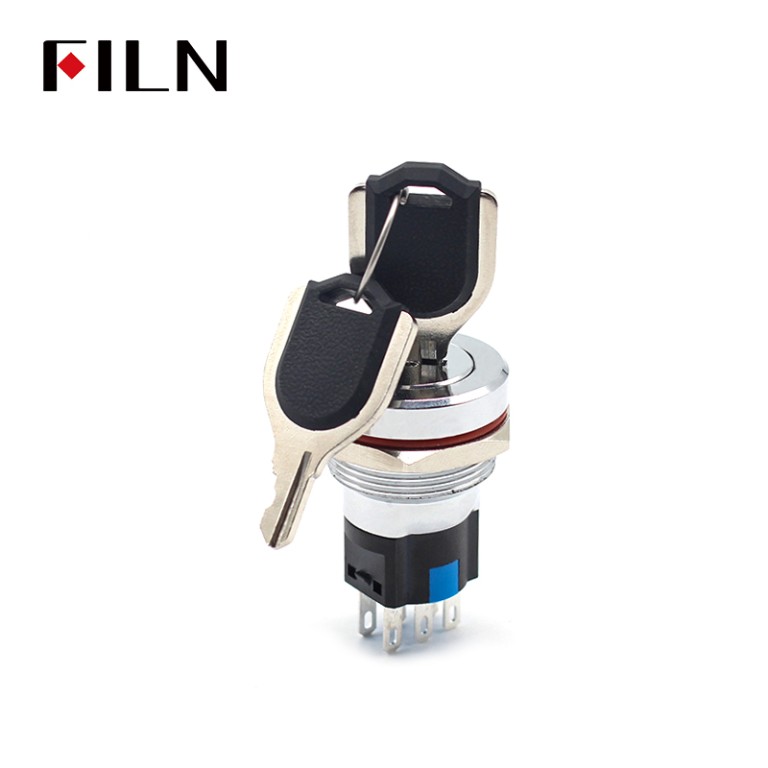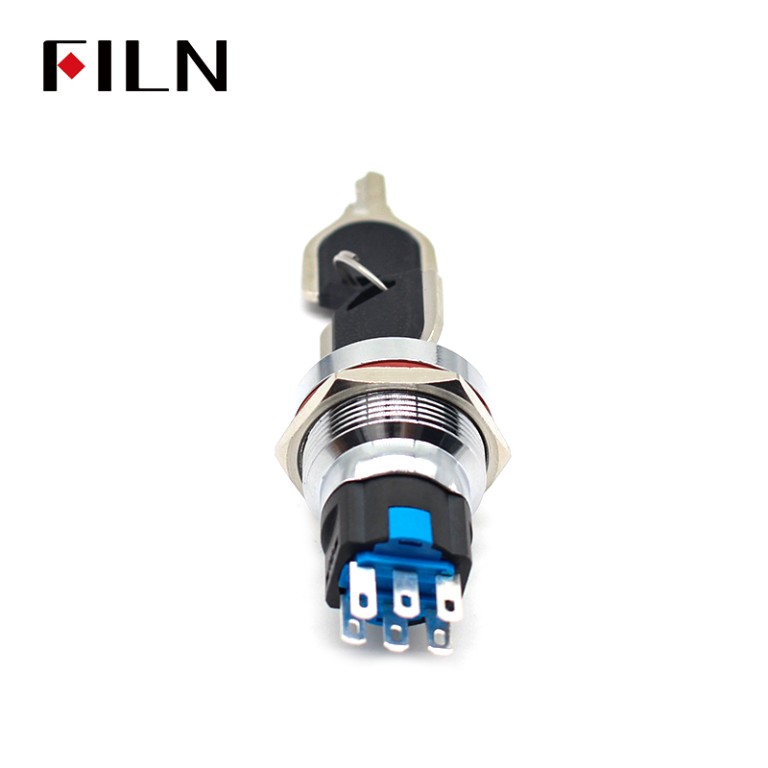Product Drawings:
Comprehensive Guide to Switch Button Type: All You Need to Know
- Name:Switch Button Type
- Model:FLGQ22
- Head Type:Flat Head
- Size:22mm
- Switching Functions:Momentary
- Contact Configuration:2NO2NC
- Rated Voltage: 1A(DC)0.5A(AC)
- Voltage Options:36V(DC) 250(AC)
- Material:ABS plastic, Plastic
- Download Certification:CE, CCC, ROSH, UL
- Email:inquiry@cnylin.com.cn

Product Parameters:
| Production Series | FLGQ22 | Light Guide Button | |
| Button Shape | round | Actuator | ABS plastic |
| Button LED Color | Housing Sleeve | ABS plastic | |
| Mechanical Life | The 500 thousand time | Button Pin | 22AWG PVC wire(0.3MM2) |
| Electrical Life | The 100 thousand time | Rubber Ring | SIL silica gel |
| Protection Level | Nut | H59 nickel plated brass | |
| Rated Voltage | 36V(DC) 250(AC) | Housing | ABS plastic |
| Rated Current | 1A(DC)0.5A(AC) | Light Source | |
| Rated Power | 36W(DC)125W(AC) | size | 22mm |
| Operating Temperature | -25℃~+85℃ | Contact | AgCdO12 |
How to wire a switch button type with led?
In electrical circuits, how you wire a switch button type can affect not only the operation of the switch itself but also connected devices. Here, we explain two different circuit configurations for a switch button type, focusing on LED indicators and device operation.
The wiring way is as follows, the first step, the positive pole of the power is connected to the NO pin, the second step, connect the negative pole of power to the C pin of the switch.
Video of other button switch wiring
Customization Advantages of FILN switch button type
The FILN switch button type is a versatile product that can be customized according to the needs of different customers. This flexibility opens up an array of advantages for users, making it a sought-after component in various applications.
Why Customization is Important for switch button type ?
Customization is not just a luxury but a necessity in the ever-competitive market. Manufacturers are under constant pressure to provide products that meet specific customer needs. In the case of the FILN switch button type, customization has a significant impact in terms of functionality, aesthetics, and adaptability.
- Industry requirements differ: Different sectors have different requirements for push button switches. For example, the medical industry might require switches that are easily sterilizable, while the automotive industry may need switches that can withstand harsh conditions.
- Consumer Preferences: End-users may prefer specific symbols or lights that make the switches easier to use or identify, enhancing the user experience.
- Technological Advances: As technology progresses, the requirement for switches also changes. Customization ensures that the product remains relevant.

Customizable Button Symbols
One of the most prominent features that can be customized in a FILN switch button type is the button symbol. Customers can opt for various light symbols depending on their specific needs.
- User Experience: A customized symbol can dramatically improve user experience by providing easy identification of the button’s function.
- Branding: Companies can also opt for symbols that align with their brand identity, ensuring consistency in product design.
- Regulatory Compliance: In some industries, there are specific symbols that are required by law to ensure safety and compliance.
Customizable Voltage Options
Another crucial aspect of customization is the voltage of the push button switch. FILN offers various voltage options, such as 110v push button switches, to cater to the varied needs of customers.
- Geographic Requirements: Different countries have different standard voltages. Custom voltage options allow for the global distribution of products.
- Device Compatibility: Customizable voltage ensures that the switches can be easily integrated into different systems without requiring additional components.
- Energy Efficiency: The ability to customize voltage can help in creating energy-efficient systems.
FILN’s commitment to customization offers not just product variety but also competitive advantage. Whether it’s custom symbols, voltages, or connectors, the switch button type can be tailored to meet the unique demands of your project, making it a smart choice for a multitude of applications.
Related products:
Table of Contents
1.What is a switch button type and How Does it Work?
A switch button, often referred to as a “Pushbutton switch,” serves as an electromechanical device that controls an electric circuit. The function of a switch button is simple: it either closes or opens an electrical circuit. Pushbutton switches are highly versatile, which makes them ideal for various applications, from household items to industrial machinery. The operation of a switch button generally involves pressing, pushing, or releasing to engage or disengage the electric circuit. For more basic information about what a switch button is, check this guide.
- Mechanical Perspective: From a mechanical standpoint, a switch button comprises a set of contacts, a button cap, and a housing. Pressing the button causes the internal contacts to either come together or move apart, thereby closing or opening the circuit.
- Electrical Perspective: In electrical terms, the switch button functions as a simple input device that tells the circuit to either allow or cease the flow of electricity, effectively turning a device on or off. Learn how a push-button switch works here.
- User Perspective: For the end-user, a switch button offers a convenient and straightforward way to control a device. This could range from starting a machine, lighting up a room, or even initiating a software command in more complex systems.
2.What Are The Different Types of switch button type?
Switch buttons come in a variety of types, catering to different needs and applications. It is essential to understand these types for effective utilization and even for tasks like wiring. If you want a more detailed look at different types, you can explore this resource.
- By Functionality: The most basic categorization of switch buttons is based on their functionality. Momentary push button switches, for example, only remain active as long as they’re being pressed. Conversely, latching or push-push switches stay in their last state even after being released. Here’s a resource on 12mm push button switch types.
- By Power Rating: Switch buttons also differ based on their power rating. Some are designed for low-voltage applications, while others can handle higher voltage and current. For instance, here is a 20A push-button switch.
- By Material: The construction material also varies, from plastic for household items to rugged metal for industrial applications.
3.What Does Push Button Switch On/Off Mean?
The term “Push Button Switch On/Off” refers to the basic functionality of a push button switch, enabling or disabling a circuit when pressed. Here is a resource for push button switch On/Off.
- Simplicity: These are generally the simplest types of switch buttons, often seen in household gadgets and basic industrial equipment.
- Energy Efficiency: Because they offer straightforward On/Off operation, these types of switches are usually more energy-efficient.
- User Experience: These switches are user-friendly, allowing for intuitive control without requiring detailed knowledge of the device’s operation.
4.What Does ‘Push Button Switch Types PDF’ Refer To?
The term “push button switch types PDF” typically refers to a downloadable document that provides detailed information on the various kinds of push button switches. These documents often include specifications, wiring diagrams, and application recommendations.
- Educational Perspective: These PDFs serve as comprehensive educational resources for students, hobbyists, or professionals looking to expand their knowledge on the subject.
- Technical Perspective: From a technical standpoint, these PDFs offer detailed schematics and specifications for those involved in the manufacturing or wiring of switch buttons.
- Commercial Perspective: Manufacturers and distributors often provide such PDFs as part of their product literature to help customers make informed purchasing decisions.
5.How Does a switch button type Work?
A momentary push button switch is a type of switch that only stays active as long as it is pressed. Upon release, the circuit returns to its original state. This type of switch is commonly used in doorbells, reset buttons, and many other applications. Here’s a resource on momentary push button switches with 4 pins.
- Functional Perspective: From a functional standpoint, a momentary push button switch is suitable for applications that require a temporary change in the circuit’s status.
- Electrical Perspective: These switches usually contain a spring-loaded mechanism that separates the contacts when not being pressed, thus breaking the circuit.
- User Perspective: For the end-user, a momentary push button switch provides precise control, allowing for operations that require quick engagement and disengagement of a circuit.
6.What Is a Push Button Light Switch?
A push button light switch is a particular type of push button switch designed specifically for controlling lighting systems. These are often found in residential, commercial, and industrial settings.
- Aesthetic Perspective: These switches offer an aesthetic appeal and often come in various styles and finishes to match the interior decor.
- Functional Perspective: Functionally, they work like other push button switches but are designed to handle the electrical load of lighting systems.
- Technological Perspective: Modern versions of these switches incorporate smart technology, allowing for remote control and programmable settings.
7.What is a Push Push Switch?
A push push switch is a type of latching switch that toggles between its on and off states each time it is pressed. Unlike momentary switches, these maintain their state after being released.
The Three Perspectives on Push Push Switch
- Mechanical Perspective: Mechanically, these switches contain a latching mechanism that keeps the contacts engaged or disengaged until the button is pressed again.
- Application Perspective: These switches are suitable for applications where you don’t want to keep holding the button to maintain its state.
- User Perspective: For the user, push push switches offer convenience, as a single press can turn a device on or off without needing to keep the button pressed.
8.How to Wire a Push Button Switch?
Wiring a push button switch involves connecting it to a circuit in such a way that it can control the flow of electricity. This generally means connecting the terminals of the switch to the power source and the device it is meant to control. For more information on how to wire a push button switch, you can visit this guide.
- Technical Perspective: From a technical viewpoint, the most important thing is to ensure that the wiring is correctto avoid short circuits or device malfunctions.
- Safety Perspective: Safety is crucial when wiring a push button switch, which means disconnecting the power source while working and using appropriate protective gear.
- Functional Perspective: Functionally, the goal is to allow the switch to control a device or circuit efficiently.
9.What is an Arduino Button?
An Arduino button is a push button switch that can be integrated into circuits controlled by an Arduino microcontroller. These buttons serve as input devices that can trigger various kinds of actions programmed into the Arduino.
- Educational Perspective: Arduino buttons are often used in educational settings to teach basic electronics and programming concepts.
- Technical Perspective: These buttons can range from simple on/off switches to more complex types that send varying electrical signals based on how they are pressed.
- Application Perspective: In practical applications, Arduino buttons can be part of larger systems, used for things like home automation, robotics, or interactive installations.
10.What is the Difference Between NO and NC Push Button?
NO (Normally Open) and NC (Normally Closed) refer to the default state of a push-button switch when it is not being pressed. In a NO push button, the circuit remains open until the button is pressed, closing the circuit. Conversely, in an NC push button, the circuit is closed by default and pressing the button opens it.
- Technical Perspective: From a technical viewpoint, the choice between NO and NC often depends on the application’s safety requirements. For example, emergency stop buttons are often NC so that a fault in the button will stop the machinery.
- Functional Perspective: NO switches are often used in applications where the device needs to be off by default for energy savings, while NC switches are common in applications requiring a default “on” state.
- User Perspective: From a user’s standpoint, the choice between NO and NC will affect the button’s functionality, so it’s essential to understand the difference before installation or use. For more insights, visit this resource on NO-NC push buttons.
11.What Are the Common Power Ratings for Push Button Switches?
Power ratings for push button switches can vary widely depending on their intended application. You’ll find switches rated for low-voltage DC circuits (like 12V or 24V) up to higher voltage AC applications (like 120V or 240V).
- Electrical Perspective: From an electrical viewpoint, it’s crucial to choose a switch with an appropriate power rating to prevent electrical failures or safety hazards.
- Commercial Perspective: Manufacturers offer a wide range of power ratings to cater to different market segments. For example, here’s a 120V push button switch.
- User Perspective: For the end-user, understanding power ratings is essential to ensure compatibility with their specific applications.
12.What Are Latching Push Buttons?
Latching push buttons are types of switches that maintain their state after being activated. Pressing the button once will change its state, and it will stay in that state until pressed again.
- Mechanical Perspective: These switches have a mechanical latch that keeps the circuit in its current state even after the button is released.
- Functional Perspective: They are often used in applications where it’s important for the button to maintain its state without continuous pressure, such as lighting or machinery control.
- User Perspective: For the user, latching push buttons offer convenience, as they don’t have to keep the button pressed to maintain a device’s operational state. For more details, visit this guide on latching push buttons.
13.How to Wire a switch button type with LED?
A push button switch with an LED requires not just wiring to control a device or circuit but also additional connections for the LED to function, often indicating the button’s current state. Here’s a helpful guide on how to wire a push button switch with an LED.
- Technical Perspective: Extra care is needed when wiring these switches to ensure that the LED and the switch function correctly. This often involves connecting resistors and ensuring the correct polarity for the LED.
- Functional Perspective: These switches serve dual purposes—controlling a circuit and providing a visual indicator—adding an extra layer of functionality.
- User Perspective: For the user, the LED indicator offers immediate visual feedback, helping them understand the device’s current state without additional checks.
Conclusion of the switch button type
Switch buttons, or pushbutton switches, are versatile components used in various applications, from simple household gadgets to complex industrial machinery. Understanding their types, functionality, and wiring is essential for effective use and safety. This comprehensive guide provides you with a multidimensional view on the subject, aiding both novice users and experienced professionals in making informed decisions.





